Special Contribution Old
Special Contribution – Click on Inductee to view Biography
Create Group and ID
1980
- G.P. “Jerry” O’Malley - Special Contribution
-
1980
Served on AAU and Olympic committees. Was Olympic fundraising chairman for the State of Oregon from 1963 through 1976. He was a founding member of the Oregon Sports Hall of Fame board of directors.
1981
- John Eggers - Special Contribution to Sports
-
1981
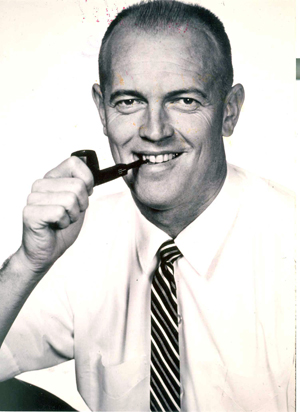 John Eggers served as sports information director at Oregon State University for more than 31 years, and helped create a pattern for how to represent and market college athletics through in-house news writing. His efforts helped significantly with Terry Baker receiving the Heisman Trophy in 1962.
John Eggers served as sports information director at Oregon State University for more than 31 years, and helped create a pattern for how to represent and market college athletics through in-house news writing. His efforts helped significantly with Terry Baker receiving the Heisman Trophy in 1962.Eggers grew up in Pendleton, and excelled in basketball, eventually earning a roster spot at Willamette University before joining the Armed Forces at the start of World War II. Upon returning to Oregon, Eggers schooled at Oregon State and became a sportswriter for the school paper, The Daily Barometer, and then The Oregonian in Portland.
Eggers became Sports Information Director in 1952 after two years as an assistant, and quickly worked to establish the school on a national level by attending annual College Sports Information Directors of America workshops in Chicago.
In 1962, his efforts helped Baker become the first Heisman winner West of the Mississippi River and then Sports Illustrated’s Athlete of the Year. The following year he was Knighted by the Rose Festival Association.
Eggers was inducted to the Oregon Sports Hall of Fame in 1982, the Oregon State University Athletic Hall of Fame in 1991 and the CoSIDA Hall of Fame in 2010.
1982
- Rube Ross - Special Contribution
-
1982
Three-year track letterman at the University of Oregon (1926-1928).
He was a founding director of the Oregon Sports Hall of Fame board of directors.
1983
- L.H. Gregory - Special Contribution
-
1983
Sports editor and columnist for the Oregonian for 52 years (1921-1973) honored by National Hall of Fame, Los Angeles Times (1955), Amos Voorhies Award by Oregon Newspaper Publishers Association (1962), countless sports writing firsts, including names for Medford "Black Tornado" football, "Tall Firs" for University of Oregon's NCAA basketball championship team of 1939.
- Murray Kemp - Special Contribution
-
1983
Founder, General Manager, President, and Chairman of Multnomah Kennel Club from 1933, recognized nationally for his contributions to greyhound racing, many innovations to pari-mutuel wagering, providing for summer employment opportunities to several hundred athletes at Oregon colleges and universities.
1984
- Robert Hudson - Special Contribution
-
1984
 Robert Hudson used his business skill and drive to support golf to the benefit of not only the state, but also the golf world during the era surrounding World War II.
Robert Hudson used his business skill and drive to support golf to the benefit of not only the state, but also the golf world during the era surrounding World War II.Born in 1887, Hudson began working in a grocery at age 14 and became the store’s sales manager at age 19. At age 20, he bought the store and started the Hudson-Duncan Company, which operated throughout Oregon and became the nation’s leading wholesale grocer during World War II.
Hudson, a member of the Portland Golf Club, took to professional golf in 1944, claiming to have never seen a pro tournament before funding the Portland Open that year with a $10,000 purse. Sam Snead won the tournament, which was played in torrential rain. Ben Hogan won in 1945 with the tournament again being funded by Hudson.
Continuing to work with the PGA, the Portland Golf Club played host to the PGA Championship in 1946. At the tournament, writers from across the nation who attended the tournament, won by Hogan, founded the Golf Writers Association of America (GWAA).
Hudson’s most heralded accomplishment was helping restart the Ryder Cup, which pits a team of professionals from the U.S. against their counterparts from Britain (now Europe) on a bi-annual basis. Hudson funded the British team so it could travel to Portland in 1947, restarting the event after a 10-year absence. The GWAA voted Hudson Man of the Year in 1947.
Hudson, who became known for golfing on Thursdays with managers within his company, sponsored the Portland Open again in 1947 and the 1955 Western Open, which was played at the Portland Golf Club.
The PGA’s Pacific Northwest Section created a Ryder Cup-style tournament in 1949 and named it the Hudson Cup, which annually pits five amateurs and five professionals from Oregon against those from Washington. Hudson sponsored the event through the ‘60s.
Hudson expanded his role within the PGA of America by serving on its Advisory Committee in the ‘50s, and helped focus the PGA Tour on customer service at events.
Hudson was inducted to the Pacific Northwest Golf Hall of Fame in 1978 and the Oregon Sports Hall of Fame in 1984.
- Multnomah Athletic Club - Special Contributions
-
1984
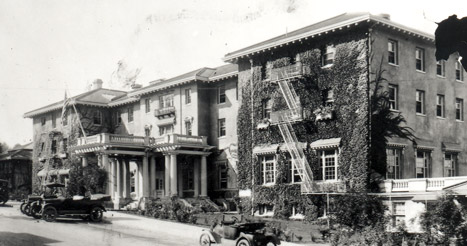
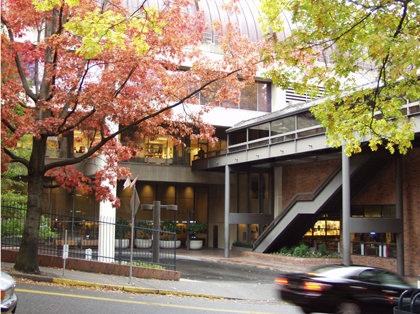 Founded in 1891, “The MAC” has become Oregon’s and one of the nation’s most storied athletic clubs, and has shaped the course of the state’s sports world for more than a century. The club was incorporated on February 28, 1891 through the efforts of 26 amateur sports athletes and enthusiasts, led by photographer Arthur B. McAlpin. They spun off from a group of 150 men who had contentiously met earlier in the week to form just such a club.
Founded in 1891, “The MAC” has become Oregon’s and one of the nation’s most storied athletic clubs, and has shaped the course of the state’s sports world for more than a century. The club was incorporated on February 28, 1891 through the efforts of 26 amateur sports athletes and enthusiasts, led by photographer Arthur B. McAlpin. They spun off from a group of 150 men who had contentiously met earlier in the week to form just such a club.The Multnomah Amateur Athletic Club charged an initiation fee of $10. In a month, the club had grown to 200 members and the initiation fee had grown to $25.
In April, the club leased the third-floor of a building in downtown Portland and proceeded to purchase equipment from the Chicago-based Spalding Company, and then hired a gymnastics instructor. The club also featured a room with three billiards tables.
The MAAC delved into team competition in summer with the formation of a baseball team and formed a football team in fall. It also sponsored athletes for individual competitions and created events that attracted competitors from throughout the West, including Vancouver, B.C. From its first game against the Tacoma Athletic Club, the MAAC’s football team developed a national reputation for success, posting a record of 58 wins, 17 losses and 13 ties through 1905. It regularly played college programs, including a loss to Stanford in 1894.
Members of the MAAC competed in events from the athletic spectrum, from shooting to swimming to cycling to bowling from its opening. The club also developed its social side, sponsoring smokers, cultural exhibitions and events such as “Ladies Nights,” throughout its first decade. The club sent the first of its members to an Olympic Games in 1906.
The club constructed its first clubhouse at Southwest 10th and Yamhill in 1900 on land it purchased the previous year. At the time, the club promoted regular bathing, which it promoted as decreasing ailments, and charged members for towels.
The club removed “amateur” from its name in 1936. Since its beginnings, dozens of club members have competed in Olympics Games. It has built and rebuilt several clubhouses, including two destroyed by fire, and constructed the concrete grandstand for Multnomah Stadium in 1926. The grandstand is still in use as part of Jeld-Wen Field.
The club even survived a movement that would have made it a social club in the early 1960s. It required members, starting in 1965, to be talented athletes, and expanded its clubhouse through the sale of Multnomah Stadium to the City of Portland for $2.1 million in 1966.
Membership has surpassed 20,000 and the current clubhouse of 550,000 square feet has allowed it to be called the largest indoor athletic club in the world. It was inducted to the Oregon Sports Hall of Fame in 1984.
Amazingly, the club’s emblem, “Winged M,” has remained virtually unchanged since its creation shortly after the club opened.
1985
- George Yerkovich - Special Contribution
-
1985
A native of Portland, George Yerkovich, has combined distinguished years of service in sports with a notable career in politics. He was four times elected auditor for the City of Portland, attended Portland’s Washington High School and Southern Oregon College where he participated in three sports. At Southern Oregon he won the Southern Oregon-Northern California Jack Dempsey Boxing Tournament light heavyweight championship.
Yerkovich refereed basketball for 20 years, including many seasons in the Pacific Coast Conference. He was involved with the boxing, basketball, wrestling, and weightlifting programs at the Multnomah Athletic Club. He was also a charter member of the Oregon Sportswriters and Sportscasters.
He helped build Little League ball parks and coached youth basketball and baseball teams. For more than 25 years he was instrumental in athletic fundraising for Portland State.
His contributions to boxing probably are the most outstanding. He served as chairman of the World Boxing Association championship committee. He was one of only 31 men in the United States to serve on the executive board of the World Boxing Council. He was executive secretary of the Portland Municipal Boxing Commission and chairman of the March of Dimes Fight for Life boxing program.
Winner of several awards during his career we now add the Oregon Sports Hall of Fame’s Marion J. Pericin Special Contribution to Sports Award to his accolades.
1986
- Harry Glickman - Special Contribution to Sports
-
1986
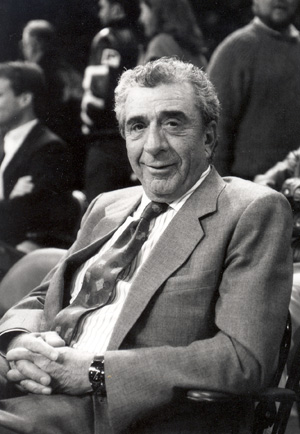 Among the Oregonians who’ve been involved with the promotion and development of professional events and teams in Oregon, Harry Glickman stands alone for his work in founding, developing and then maintaining the state’s most successful events and teams, including the Portland Trail Blazers.
Among the Oregonians who’ve been involved with the promotion and development of professional events and teams in Oregon, Harry Glickman stands alone for his work in founding, developing and then maintaining the state’s most successful events and teams, including the Portland Trail Blazers.He is regarded as “The Father of Pro Sports in Oregon.”
Born in Portland in 1924, Glickman played basketball at Lincoln High School and, upon graduation in 1941, attended the University of Oregon, where he earned a Bachelor’s Degree in Journalism. At Oregon, he served as director of the university’s athletic news bureau, and wrote for the school paper as well as the Eugene Register-Guard.
Throughout the 1950s, he promoted boxing matches and preseason games for National Football League teams at Portland’s Multnomah Stadium before finding a group of investors to purchase a franchise in the Western Hockey League in 1960.
Under Glickman’s guidance as General Manager, the Portland Buckaroos were an immediate success and won the league title in their first year, while regularly attracting more than 10,000 fans per game into Memorial Coliseum, which opened in 1960. The Buckaroos won WHL titles in 1961, ’65 and ’71.
Although professional hockey expanded several times in the ‘60s, and Glickman remained dedicated to the sport until the Buckaroos folded in 1974, he sought an expansion team for Portland in the late ‘60s. That franchise became the Portland Trail Blazers.
Glickman ran the Blazers as General Manager, while also running the Buckaroos for several seasons as its owner.
Glickman oversaw the roster moves that built the Blazers into the NBA champions in 1977, and served as GM until 1987, when the original investors sold the team to Paul Allen. He served as team president until 1994, when the Blazers moved from Memorial Coliseum into the Rose Garden.
He remains President Emeritus of the Blazers.
In honor of his work in promotion, the media center at the Rose Garden is named for him, as is the annual honor for the state’s top amateur athlete at the Oregon Sports Awards. He wrote his autobiography, “Promoter Ain’t a Dirty Word,” in 1977, and was cited as Portland’s First Citizen in 1992.
Glickman, who lives in Portland, was inducted to the Oregon Sports Hall of Fame in 1986. He is also a member of the Jewish Sports Hall of Fame.
- George Pasero - Special Contribution
-
1986
For more than 45 years in the newspaper business – more than 28 as a sports columnist – George Pasero remains not only widely respected by his professional colleagues, but a beloved friend to most people who have known him during his career.
The son of Italian immigrant parents who raised their four sons in St. Helens, Pasero attended Oregon State College in 1935 to study chemical engineering. However, he came home to St. Helens for a year and went to work for a local paper mill. In 1937 he enrolled at the University of Oregon and upon graduation in 1940, took his first newspaper job as a promotional department trainee for $15 a week and as George recalls: “I was high paid.”
He joined the Navy in 1942 during World War II and served four years. When he returned in 1946 it was either back to the paper mill or back to The Journal. Fortunately for newspaper readers, he chose the latter, eventually becoming Journal sports editor in 1956.
His daily column in the Oregon Journal was called “Pasero Says” and after running more than 25 years up to six times a week, it moved to The Oregonian in 1982 when the two newspapers merged. George continues to write his column once a week for the Sunday Oregonian.
Memories…personalities…great moments in sports. All are woven into the rich tapestry that is George’s career – a career for which we honor him with the State of Oregon Sports Hall of Fame’s Marion J. Pericin Award for Special Contribution to Sports.
1987
- Al Lightner - Special Contribution
-
1987
Athlete…sports official…organizer…journalist. The tags all fit when applied to Salem’s own Orland “Al” Lightner.
Born in Colorado, he attended grade and high school in Stockton, California and later attended Compton Junior College where he captained the baseball team which competed against major league great Jackie Robinson.
He signed with the Hollywood Stars of the Pacific Coast League in 1938 and later played at Bellingham before coming to Salem in 1940 as a member of the first Salem Senator’s team. He’s lived in Salem ever since.
In the last 47 years, Al Lightner’s contributions to sports have been many. He started junior baseball programs and coached in youth leagues. But perhaps his biggest contribution as a participant was as a referee in football for 30 years and in basketball for 25 years. In basketball he was rated the No. 1 major college official on the West Coast; more than 20 years participating in 11 NCAA regional and four “Final Four” tournaments.
Lightner was as Oregon horse racing official for 30 years and sports editor of the Salem Statesman newspaper for 34 years.
Inducted into the NAIA District Hall of Fame in 1976 and the Stockton, California Athletic Hall of Fame in 1982, he joins the State of Oregon Sports Hall of Fame tonight by receiving the Marion J. Pericin Award for Special Contribution to Sports.
1988
- Bob Newland - Special Contribution
-
1988
The most successful high school track and field coach in the state's history, winning nine state championships and finishing second once from 1948 through 1957. Newland was an all-Southern Oregon Conference quarterback two years, an all-conference guard in basketball three years, and a two-time state high jump champion.
Newland won numerous honors for athletics administration. He was a three-time meet director for four NCAA championships, two national AAU championships, and on Pan American Games trials. He was director of the Oregon Indoor meet from 1961-1978 and directed every University of Oregon track meet for 20 years.
- Tournament Golf Foundation - Special Contribution
-
1988
Tournament Golf Foundation is a group of 40 area businessmen and their wives that have been bringing the LPGA Tournament to Portland for over 16 years. The organization has raised $1.4 million in prize money and over $600,000 in charity contributions since 1972.
This group works every year to involve sponsors, sell tickets, and run pro-am spots to raise the necessary capital to fund the purse and to run the championship event. Three worthy charities reap the financial rewards. The designated charities are: Waverly Children's Home, Evans Scholars Foundation, and Oregon Junior Golf Association.
1989
- NIKE - Special Contributions
-
1989
From a waffle iron and the trunk of a car, Nike is one of Oregon’s – and America’s – most inspirational business success stories.
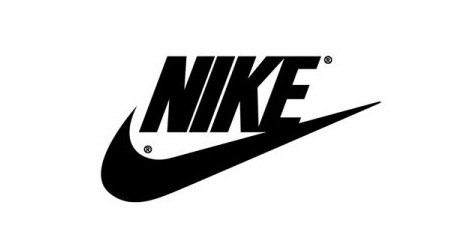 The company began in 1964 when former University of Oregon runner Phil Knight and Oregon track and field coach Bill Bowerman put in $500 each to form Blue Ribbon Sports. Knight, a graduate of Cleveland High, Oregon and the Stanford Graduate School of Business, had already secured the distribution rights to the West Coast from a Japanese shoe company that sold Tiger brand running shoes.
The company began in 1964 when former University of Oregon runner Phil Knight and Oregon track and field coach Bill Bowerman put in $500 each to form Blue Ribbon Sports. Knight, a graduate of Cleveland High, Oregon and the Stanford Graduate School of Business, had already secured the distribution rights to the West Coast from a Japanese shoe company that sold Tiger brand running shoes.With Knight’s business and sales drive and Bowerman’s support and credibility, Blue Ribbon Sports prospered with Knight regularly selling shoes from the trunk of this car at track meets. It took five years, though, for Knight to leave his job as an accountant in Portland and work full-time for the company.
Blue Ribbon Sports began producing and marketing its own shoes – soccer shoes called Nike - in 1971 and developed the Swoosh a year later. The company began selling running shoes at the 1972 U.S. Olympic Track and Field Trials that were held in Eugene. The shoes included the now famous “waffle” soles, the design having come from Bowerman pouring urethane into his wife’s waffle iron.
The company gained national and international exposure from Steve Prefontaine, who used and promoted the shoes until his untimely death in 1975. Blue Ribbon Sports continued to promote its Nike running shoes and then officially changed its name to Nike, Inc., in 1978.
Nike grabbed as much as 50 percent of the U.S. market and went public in 1980. Since then, Nike has become an icon in the sports world, developing the slogan “Just Do It” in 1988, using Michael Jordan’s name to brand a line of basketball shoes and apparel, and Tiger Woods for golf shoes and apparel.
Nike has acquired a variety of footwear and apparel companies, including Cole Haan, Converse, even Hurley International, a maker of surf apparel.
The Swoosh, originally designed by a student at Portland State, is known worldwide. Based in Beaverton, Nike is one of Oregon’s two remaining Fortune 500 companies.
1990
- Harold Taylor - Special Contribution
-
1990
A native of Laurel, Oregon and a 1930 graduate of Estacada High School, Harold Taylor founded Taylor Electric Supply with a four-person staff more than 30 years ago and now employs 115 people in Southeast Portland. His company sponsors Junior, American Legion, and City League Baseball and Pop Warner Football. The baseball field at Rex Putnam High School is named in his honor.
He was saluted by the Oregonian Banquet of Champions in February for his contributions to youth baseball and softball. Taylor and his wife, Margaret, have a Presidential Scholarship at the University of Oregon and scholarship programs at North Clackamas School District No. 12 and Estacada Union High School District No. 108.
1991
- Joe Loprinzi - Special Contribution to Sports
-
1991
 Joe Loprinzi left his mark on the state as a fitness and weightlifting coach and athletic guru enough so that the Multnomah Athletic Club named a wing after him.
Joe Loprinzi left his mark on the state as a fitness and weightlifting coach and athletic guru enough so that the Multnomah Athletic Club named a wing after him.Born in Portland in 1914, Loprinzi grew up in an athletic family that included three brothers. As a 9-year-old, Joe Loprinzi took in a strongman show at a local theater and delved into weightlifting. In 1930, Joe Loprinzi and his brothers opened a gym, the Portland Barbell Club, and four years later were accepted as members in the MAC. In 1937, Joe Loprinzi, who had frequently competed as a weightlifter for the club, began working as a fitness instructor and weightlifting coach. He later turned his coaching skills to numerous other sports.
Throughout the 1960s and 70s, Loprinzi, who served in the Navy in World War II, offered fitness advice to viewers of the KGW TV morning program.
In 1988, the MAC created the Joe Loprinzi Inspirational Award, given annually to the club member who best exemplifies the spirit for fitness he exhibited. The Multnomah Athletic Foundation later named a scholarship for him.
In 1997, upon Loprinzi’s retirement after 60 years of service, the MAC announced it would name its new West Wing for him.
Loprinzi, affectionately called “Mr. Mac” was inducted to the Oregon Sports Hall of Fame in 1991. He passed away in 2009 at age 95.
1992
- Leo Harris - Special Contribution
-
1992
(Aug. 6, 1904 - Apr. 22, 1990) Leo Harris was the first athletic director at the University of Oregon and from 1947 to 1968 held that position. Harris was a financial wizard. Among his major accomplishments at Oregon were the construction of Autzen Stadium (completely paid for on opening day), improvements at Howe Field and Hayward Field, and the expansion of MacArthur Court. In addition, Harris hired such long term Oregon coaches as Bill Bowerman in track, Len Casanova in football, Don Kirsch in baseball, and Steve Belko in basketball.
Harris was also noted for striking a handshake deal with Walt Disney in 1947 that allowed Oregon to use the likeness of Donald Duck as the University's athletic mascot, The Oregon Duck. When Disney lawyers in the 1970's discovered that no written contract existed, the university produced a photograph of Harris alongside Walt Disney wearing a Donald-emblazoned Oregon jacket as proof that an agreement did exist. From that photo evidence, a formal contract licensing Donald's use by the university was created.
1993
- Rocky Benevento - Special Contribution
-
1993
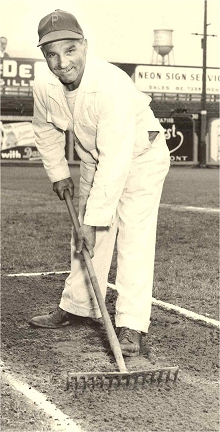
“Mr. Baseball” Rocky Benevento, the legendary Portland Beaver groundskeeper, was the frame that held Beaver Baseball together for almost four decades (1927-1966), His love of baseball fueled fans’ support for the game and admiration and respect for Rocky. Rocky never missed hospital visits (fans and players), boarded new players at his home, let neighborhood kids in the fame for free, and worked diligently to maintain the Beaver’s facility.
Rocky Benevento represents an era: capacity crowds at Vaughn Street, pus lawn mowers, and roasted peanuts. Rocky died in 1969 but through his good citizenship and love for baseball still lives in the memories of thousands of Beaver baseball fans.
1995
- Jimmy Jones - Special Contribution
-
1995
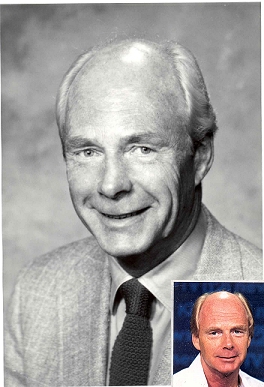 For 20 years sports director for KPTV Channel 12 in Portland, Jimmy Jones remained one of the most recognized figures in Oregon sports. The television voice of the Portland Trail Blazers for 13 years before taking a position with the Seattle SuperSonics in 1983, Jimmy covered virtually every major sporting activity in Oregon including sports involving both the University of Oregon and Oregon State, the Portland Buckaroos in hockey, the Portland Timbers in soccer, and professional football in the television play-by-play commentator for Prime Sports. Testimony to the respect shown to Jimmy by his broadcasting peers is the fact that, while in Oregon, they named him Oregon Sportscaster of the Year seven times.
For 20 years sports director for KPTV Channel 12 in Portland, Jimmy Jones remained one of the most recognized figures in Oregon sports. The television voice of the Portland Trail Blazers for 13 years before taking a position with the Seattle SuperSonics in 1983, Jimmy covered virtually every major sporting activity in Oregon including sports involving both the University of Oregon and Oregon State, the Portland Buckaroos in hockey, the Portland Timbers in soccer, and professional football in the television play-by-play commentator for Prime Sports. Testimony to the respect shown to Jimmy by his broadcasting peers is the fact that, while in Oregon, they named him Oregon Sportscaster of the Year seven times.
1996
- Ormond Bean - Special Contribution
-
1996
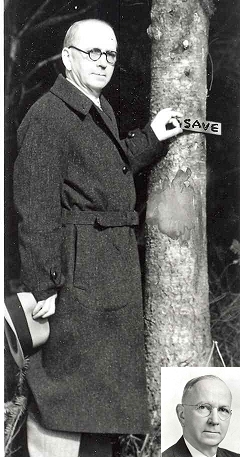 A Portland City commissioner for 14 years (1932-39; 1949-56), Ormand Bean was an expert in city planning and a leader in acquiring land for Portland’s city parks. He played a major roll in creating Normandale and Farragat Parks and in acquiring the land for developing West Delta Golf Course, now known as Heron Lakes.
A Portland City commissioner for 14 years (1932-39; 1949-56), Ormand Bean was an expert in city planning and a leader in acquiring land for Portland’s city parks. He played a major roll in creating Normandale and Farragat Parks and in acquiring the land for developing West Delta Golf Course, now known as Heron Lakes.Bean’s foresight and initiative to enhance the livability of the City of Roses are major reasons why Portland developed one of the finest city park systems in the United States. His work earned him the title of “Father of the Portland Park System”.
1997
- Pendelton Round-Up - Special Contribution
-
1997
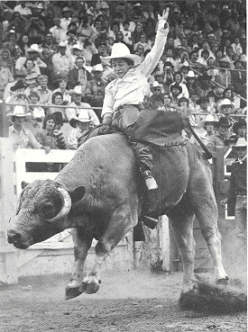 Community members of Pendelton Oregon organized the first Pendelton Round-Up in September 1910. Operated by a non-profit organization, originally called the Northwest Frontier Exhibition Organization, the Pendelton Round-Up has always relied on the support of the townspeople and area ranchers. Some 500 volunteers assist in putting on the annual event. Ranked among the nation’s top ten rodeos the round-up is #2 in per-day prize money awarded. Each September, the four day Round-Up attracts more than 55,000 visitors to Pendelton, population 14,000. Events include professional rodeo competition, the Happy Canyon evening show, the Westward Ho parade, a western art show and the Cowboy Breakfast, among others. The economic impact to the area’s economy is estimated to be over $5 million.
Community members of Pendelton Oregon organized the first Pendelton Round-Up in September 1910. Operated by a non-profit organization, originally called the Northwest Frontier Exhibition Organization, the Pendelton Round-Up has always relied on the support of the townspeople and area ranchers. Some 500 volunteers assist in putting on the annual event. Ranked among the nation’s top ten rodeos the round-up is #2 in per-day prize money awarded. Each September, the four day Round-Up attracts more than 55,000 visitors to Pendelton, population 14,000. Events include professional rodeo competition, the Happy Canyon evening show, the Westward Ho parade, a western art show and the Cowboy Breakfast, among others. The economic impact to the area’s economy is estimated to be over $5 million.
1998
- Rolla Vollstedt - Special Contribution
-
1998
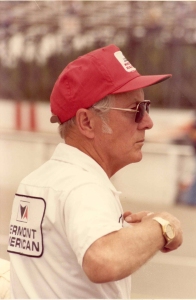 For over twenty-five years, Rolla Vollstedt was a name to be reckoned with on the auto racing circuit. He was internationally recognized for his design and construction of racecars. His cars competed at the Indianapolis 500 for ten straight years, a feat unequaled at the time by any other championship car builder.
For over twenty-five years, Rolla Vollstedt was a name to be reckoned with on the auto racing circuit. He was internationally recognized for his design and construction of racecars. His cars competed at the Indianapolis 500 for ten straight years, a feat unequaled at the time by any other championship car builder. During his outstanding career Rolla is credited with many “firsts” including designing and building the first rear-engine Offenhauser powered Indy race car (a design now used by all national championship car builders), running the first rear-engine car to use and aerodynamic wing to improve traction, and bringing the first woman driver, Janet Guthrie, to Indianapolis.
Rolla put his first car on a track in 1947 when he hired another Oregon Hall of Famer Len Sutton to drive for him. Other drivers who drove for Vo9llstedt include the late world champion Jimmy Clark, Bobby Unser, Mario Andretti, Cale Yarborough, Gordon Johncock, Dick Simon and Johnny Rutherford. Vollstedt received Builder of The Year honors in 1964, 1965, and 1966.
1999
- Dorothea Lensch - Special Contribution
-
1999
 Dorothea Lensch was named Portland Parks and Recreation’s first Director of Recreation in 1937. She envisioned recreation programs that would change the lives of children by exposing them to the possibilities provided through the arts, sports and other recreational activities. She designed a Recreation Division that developed a comprehensive plan and program which served all neighborhood age levels in sports, physical activities, dance, music, arts, crafts and social recreation.
Dorothea Lensch was named Portland Parks and Recreation’s first Director of Recreation in 1937. She envisioned recreation programs that would change the lives of children by exposing them to the possibilities provided through the arts, sports and other recreational activities. She designed a Recreation Division that developed a comprehensive plan and program which served all neighborhood age levels in sports, physical activities, dance, music, arts, crafts and social recreation. During her tenure, the number of city facilities for parks and recreation increased from three to eighteen. Three major stadiums, ball fields, tennis courts and swimming pools were also added during this time. She developed an extensive recreation program for shipyard workers and their families during World War II. Dorothea retired in 1974 after 37 years, but remains an active supporter of children’s programs to this day.
2000
- Philip H. Knight - Special Contribution
-
2000
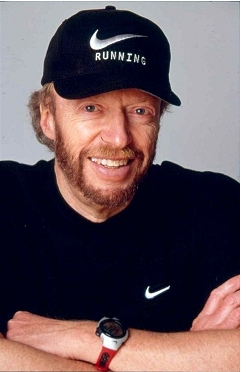 Phil Knight graduated from the University of Oregon with a personal best in the mile run of 4 minutes 10 seconds. While studying for his eventual MBA from Stanford University, Knight wrote a marketing paper on the potential of manufacturing athletic shoes in Asia. While visiting Japan, he discovered Onitsuka Tiger, a company that made inexpensive, high-quality running shoes. Knight decided to put his money where his pen was and with a $500 investment matched by partner Bill Bowerman, Knight began Blue Ribbon Sports in 1964.
Phil Knight graduated from the University of Oregon with a personal best in the mile run of 4 minutes 10 seconds. While studying for his eventual MBA from Stanford University, Knight wrote a marketing paper on the potential of manufacturing athletic shoes in Asia. While visiting Japan, he discovered Onitsuka Tiger, a company that made inexpensive, high-quality running shoes. Knight decided to put his money where his pen was and with a $500 investment matched by partner Bill Bowerman, Knight began Blue Ribbon Sports in 1964. Their new company imported Tigers, with Bowerman designing and Knight selling shoes out of the back of his car at high school track meets. Knight continued to work as a CPA, becoming an Assistant Professor of Business Administration at Portland State University. In 1969, Knight devoted himself full-time to Blue Ribbon Sports, becoming chairman and CEO of the fledgling company.
Worried that Tiger would find a more established distributor, he and Bowerman developed their own brand name, Nike, after the winged goddess of victory. Knight paid an advertising student in Portland State $34 to design the logo. It was now up to the research and development department to devise a product upon which to place that logo. The man who Knight called “part genius, part madman and the best coach I ever had” did not disappoint. Bowerman experienced his now-famous epiphany after looking at his wife’s waffle iron.
In 1972, the waffle-soled running shoe was born and it was just the first step in a race that Nike would win to become the world’s leading designer and marketer of athletic footwear, apparel, and equipment. Knight inspired many innovations in the business of sports including futures-based ordering, substantial investment in product research and development, and styling ties between product and athlete. Nike went from sales of less than $3 million in 1972 to sales of almost $270 million in 1980 in running, basketball, and tennis shoes. Sales hit $1 billion in 1986 and then came a challenge from rival Reebok.
Knight then took Nike to the next level with some of the most creative and memorable marketing and advertising the business world has ever seen. Utilizing the talents of Portland ad agency Wieden and Kennedy, Nike made popular icons of athletes such as Michael Jordan, Bo Jackson, and Andre Agassi; and slogans such as “Just Do It” became part of everyday conversation. These tactics, along with continued innovative product designs, helped Nike to record profits in the 1990’s reaching nearly $9 billion in revenue in 1999. Such success has allowed Knight to make numerous philanthropic donations to a variety of academic and sports organizations, including over $50 million to his alma mater, the University of Oregon.
2005
- Knott Street Boxing Club - Special Contribution
-
2005
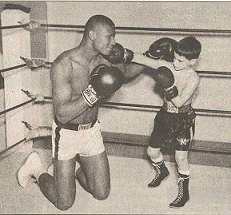 The Club brought the national spotlight to Portland with the most successful amateur boxing program in the country. The club had nine National Amateur Athletic Union Champion boxers.
The Club brought the national spotlight to Portland with the most successful amateur boxing program in the country. The club had nine National Amateur Athletic Union Champion boxers.In 1961, Knott Street won the U.S. Team Boxing Championship. Two Knott Street boxers participated in the 1964 U.S. Olympic Boxing Trials and three participated in the 1968 U.S. Olympic Boxing Trials. In 1968, Knott Street was the only amateur boxing team in U.S. history to have three National Champions on the same team at the same time. The club has produced many recognizable names including Adofo Akil, Michael Colbert, Steve Forbes, Jodie Harris, Joe Hopkins, Johnny Howard, Louis Johnson, Oregon Hall of Famer Ray Lampkin Jr., Chuck Lincoln, A. Halim Rahsaan, Wade Smith and Thad Spencer. The list of names could continue on and on. Administration, coaches and athletes, Knott St. Boxing Club truly made a special contribution to the State of Oregon .
2008
- Tinker Hatfield - Special Contribution to Sport
-
2008
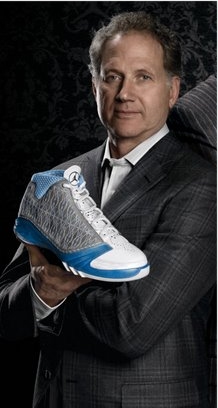 Born in Hillsboro, Oregon on April 30, 1952, Tinker Hatfield attended Central Linn High School where he earned distinction as an accomplished basketball player, an All-American Track & Field star in hurdles and vaulting. He was an All State running back and Sunkist All American (Top 100). In 1970, Tinker was named State of Oregon’s top individual high school athlete.
Born in Hillsboro, Oregon on April 30, 1952, Tinker Hatfield attended Central Linn High School where he earned distinction as an accomplished basketball player, an All-American Track & Field star in hurdles and vaulting. He was an All State running back and Sunkist All American (Top 100). In 1970, Tinker was named State of Oregon’s top individual high school athlete.Tinker studied architecture at the University of Oregon while being coached by the legendary Bill Bowerman, co-founder of Nike. He held the UO record in the pole vault and placed sixth in the 1976 Olympic trials. After graduation, Tinker practiced architecture in Eugene until 1981 when he joined up with Nike to design offices, apparel showrooms and Nike retail outlets.
In late 1985, Tinker began designing Nike products, becoming Creative Director of product design in 1989. Tinker was named Vice President of Nike Design in 1993. In addition to helping design the first ever cross training shoe (the Air Trainer) Tinker has earned global recognition for imagination and innovation in his collaborations with Michael Jordan for the Air Jordan line.
In 1998, Fortune Magazine named Tinker one of the 100
Most Influential Designers of the century. Some of Tinker’s design work for the Air Jordan is included in the Smithsonian Museum for design. More recently he has been the subject of sneaker collector documentaries and cover stories on several magazines such as Sole Collector.Tinker currently creates specialized Nike athletic products for champion athletes including LeBron James, Kobe Bryant, Roger Federer, Laird Hamilton, Gabrielle Reece, and numerous Track and Field Athletes. He also spends time mentoring young Nike designers and helping to build the Nike of the future.
Tinker is primarily responsible for the re-branding of University of Oregon, including conceptualizing the O, redesigning uniforms; changing colors, and contributing architectural artwork such as designing the new U of O video replay board.
- Candi Murray - Special Contribution
-
2008
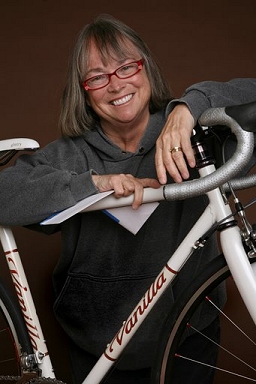 Candi Murray is recognized as the mother of Oregon bike racing, heading up one of the most successful independent racing associations in the country, the Oregon Bicycle Racing Association (OBRA). For over 20 years, she has provided the organization with business leadership, helping it achieve one of the highest membership levels of any state in the country. Under her leadership, OBRA has grown to over 3000 members; created an automated phone system for race information; invested in equipment and support transportation vehicles; and established a robust web presence for the association.
Candi Murray is recognized as the mother of Oregon bike racing, heading up one of the most successful independent racing associations in the country, the Oregon Bicycle Racing Association (OBRA). For over 20 years, she has provided the organization with business leadership, helping it achieve one of the highest membership levels of any state in the country. Under her leadership, OBRA has grown to over 3000 members; created an automated phone system for race information; invested in equipment and support transportation vehicles; and established a robust web presence for the association.Keeping bike racing local and fun has been her focus, resulting in Oregon ranking # 2 in number of cycling events (second only to California); #3 in number of amateurs (behind only California and Colorado); and ranking #1 in terms riders per capita.
Among Murray’s other achievements, she was Commissioner of Cycling for Nike’s World Masters Games, and was instrumental in leading the redevelopment of the Alpenrose Velodrome.
2009
- Anna Maria Lopez - Special Contributor
-
2009
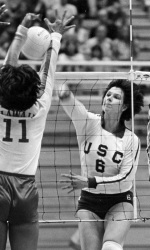 The face of St. Mary’s Academy athletics from her playing days to her current job as athletic director, Anna Maria Lopez is as distinguished as a role model as she was a competitor.
The face of St. Mary’s Academy athletics from her playing days to her current job as athletic director, Anna Maria Lopez is as distinguished as a role model as she was a competitor.Between 1974 and 1978, Lopez was the dominant female prep athlete in the state, some might say dominant athlete period.
A four-sport athlete for St. Mary’s Blues, Anna Maria’s season never seemed to end. She led the volleyball team to a pair of state championships, winning three all-state honors. Basketball yielded two all-state awards. On the softball diamond, Lopez became an ASA all-American. And she still had time to win the state discus championship…. Twice. Not surprisingly, she was named Oregon Prep Athlete of the Year as a senior.
At the University of Southern California, Anna Maria settled for two sports. A 4-year letter winner in volleyball, she was part of two National Championship teams. Lopez also lettered three years in basketball.
Volleyball was her ticket to a professional career, Lopez was an all-star of Major League Volleyball.
Coaching was next as the prodigal daughter returned to Saint Mary’s in 1984. Anna Maria was just as successful in that venture, honored as state coach of the year for
volleyball and track and field.After receiving her masters degree from Portland State, Lopez added athletic director to her resume and, yes, she would also be honored as Oregon’s top athletic director in 2001.
- Chuck Richards - Special Contributor
-
2009
The president of the Oregon Sports Hall of Fame has lived his dream of bringing sports and fitness to the community many times over.
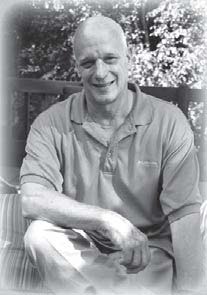 Chuck Richards was a three-time All-American while at Stadium High School in Tacoma in the early 1960s. Richards won six Washington state championships in freestyle, butterfly and individual medley.
Chuck Richards was a three-time All-American while at Stadium High School in Tacoma in the early 1960s. Richards won six Washington state championships in freestyle, butterfly and individual medley.During his senior year, he held seven of the eight individual state records.
After high school, Chuck attended Indiana University, where he was a two-time Collegiate All-American. His specialty was modern pentathlon, a traditional multi-event competition that highlights the multiple duties of a military courier; equestrian, pistol shooting, swimming, fencing and cross country running.
Richards won the Junior Modern Pentathlon Championship in 1967 and become the Modern Pentathlon record holder in the 300-meter swim in 1969.
Richards won three consecutive national championships in modern pentathlon culminating with the Olympic year of 1972.
In Munich, Chuck won the Pentathlon 300-meter swim with
an Olympic and World Record time. He was the highest scoring
American in the ’72 games.In 1977 he opened what is now known as the Sunset Athletic Club in Cedar Mill, across the street from Sunset High School and has continued to support and advocate for sports, fitness and the Hall of Fame itself. Chucks guidance of the Oregon Sports Academy bingo program has raised thousands of dollars for amateur athletes and club sports in the state of
Oregon over the last 25 years.Chuck Richards is a shining example of what Olympians do after their time as competitors has passed. They continue to work for the good of sport all who enjoy it.
2010
- Jack Elder - Special Contribution
-
2010
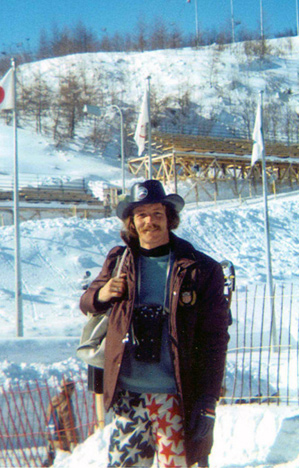 Jack Elder is an Olympian with some very big ideas. 1984 was not the first time he asked the questions “what if” or “why not”. But it was when he joined Winter Olympics Oregon (or WOO) with its purpose of bidding to host the Winter Olympic Games. It hasn’t happened yet, but jack Elder can be a very persistent man.
Jack Elder is an Olympian with some very big ideas. 1984 was not the first time he asked the questions “what if” or “why not”. But it was when he joined Winter Olympics Oregon (or WOO) with its purpose of bidding to host the Winter Olympic Games. It hasn’t happened yet, but jack Elder can be a very persistent man.His first success in sport was when he earned his Judo Blackbelt at age 17. During a stint in the Army he picked up the sport of Luge and pursued that opportunity all the way to the 1972 Olympic Games in Portland’s sister city Sapporo, Japan. After the Games it was a career in radio broadcasting for more than a decade.
Jack has always believed that athletes, especially Olympians, should give back, to their sport, to their country and to their community. In 1989, he launched Oregon Sports Action to raise awareness for under recognized sports and to expand interest in hosting athletic events in Oregon. While an Olympic bid never materialized for WOO, a conversation was started. Jack is good about starting conversations.
In a casual conversation at a 1988 Olympic committee meeting, Jack learned that an Olympic qualifying basketball tournament might have to be moved. In 1992 The Dream Team and the Tournament of the Americas was held in Portland, a result of that casual conversation.
Jack’s next conversation was about a sports commission to pursue events for Oregon. From that conversation came the Oregon Sports Authority.
Oregon Sports Action with Jack at it’s helm, is dedicated to continuing the development of all manners of sport in Oregon. Oregon sports Action has quietly donated well over one million dollars to sports organizations and the Oregon Sports Hall of Fame, the repository of Oregon Sports history.
Jack Elder continues to ask the question, “What can Olympians do to give back?” He gives back with his passion for celebrating the athlete in all of us.
- Dwight Jaynes - Special Contribution
-
2010
You know him these day as “The Godfather.” That is an appropriate moniker for Dwight Jaynes after 25 years as a Portland newspaperman and, now a multi-platform journalist, still revered for telling it like it is.
He is Rose City by birth, attended Cleveland High School and Portland State University, fortunate to have mentors who also have become members of this hall of fame, coaches Jack Dunn and Roy Love.
An early brush with journalism at a school newspaper was a spark. Dwight landed a job at the Oregon Journal as a young man. He flourished, again surrounded by mentors, this time Ken Wheeler, Bill Mulflur, and the great George Pasero.
After the merger of the Journal and Oregonian, Jaynes was handed the Trail Blazer beat in 1984 and ran with it like a pro. Dwight knew how to cultivate contacts and set the standard for working a pro sports beat. When an opportunity to write a column beckoned, Dwight became a must read, love him or hate him, he knew how to get a rise without resorting to hyperbole or sensation.
Jaynes’ NBA insight shows in two books he co-authored with Rick Adelman and long-time friend and collaborated Kerry Eggers. He was honored five times as Oregon Sportswriter of the Year.
Jaynes’ second act was a major step when he joined Pamplin Media as both editor of the Portland Tribune and talk show host on KPAM radio. Always a great guest, Dwight showed his chops on the hosting side of the mic.
These days act three is even more impressive. You can see, listen and read “The Godfather” on television, radio, and the web. His takes remain fresh, clean, lean, and mean. His sports DNA is pure Portland and it still shows. His passion for baseball in this town is singular.
One of only a handful of journalists ever to be inducted in the Oregon Sports Hall of Fame, his own story is still not completely written.
2011
- Morris "Bucky" Buckwalter - Special Contribution
-
2011
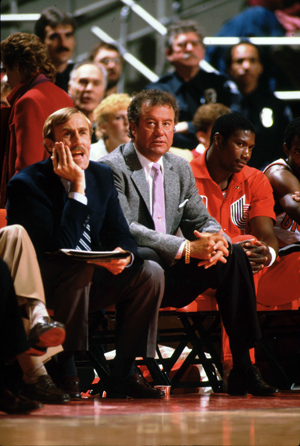 Morris “Bucky” Buckwalter went from LaGrande to the top of the pro basketball world through a career as a player, coach and then scout and executive, helping develop the Blazers roster that reached the NBA Finals in 1990 and ’92.
Morris “Bucky” Buckwalter went from LaGrande to the top of the pro basketball world through a career as a player, coach and then scout and executive, helping develop the Blazers roster that reached the NBA Finals in 1990 and ’92.Buckwalter grew up in LaGrande and played collegiately at the University of Utah, which twice reached the quarterfinals of the NCAA Tournament. Following graduation, he became a college assistant at Utah and later head coach at Seattle University.
From there, he moved to the Seattle SuperSonics of the NBA and served as an interim coach for a time in 1972. In 1973, he became coach of the Utah Stars of the ABA and signed 17-year-old Moses Malone, who later became an NBA Hall of Famer. He moved back to Portland as an assistant coach under Jack Ramsay in 1978, and became an executive in 1986.
Buckwalter’s biggest accomplishments in basketball came as a judge of player talent, including finding Jerome Kersey and Terry Porter to help build the Clyde Drexler-led Blazers of the ‘90s. The Sporting News named him NBA Executive of the Year in 1991.
Buckwalter was at the front of NBA scouts in locating talent from overseas, working for many years to sign center Arvydas Sabonis. In overseas visits to more than 40 countries, Buckwalter has claim to more than two million frequent flier miles.
He retired from the Blazers in 1997, and was inducted to the Oregon Sports Hall of Fame in 2011.
2012
- Leo Davis - Special Contribution
-
2012
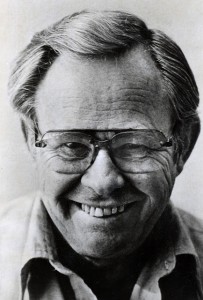 A legend of Oregon sports writing, Leo Davis had the talent to be both cruel and kind, long before punditry and hyperbole held center stage in sports journalism.
A legend of Oregon sports writing, Leo Davis had the talent to be both cruel and kind, long before punditry and hyperbole held center stage in sports journalism. The California native anchored the sports department at the Spokesman-Review in Spokane before beginning a memorable 23 year run as writer and columnist at the Oregonian.
The Oregon sports scene was different then. With no major league sports, there were stories to be told about big events both at home and away.
Davis noted the 1965 final 4 played at Memorial Coliseum was a “Weekend surrendered to basketball.”
Leo Davis also brought stories home from far flung events. He traveled to three Olympic games, 1968, 72 and 76 and became known for his coverage of track and field and the Oregon athletes representing team USA.
Davis also enjoyed writing about wrestling. His prose was lean and to the point. Of Iowa and USA wrestling legend Dan Gabel, Leo wrote in the Oregon in 1972, “Gable trains as if he’s going to row stroke on a slave galley.”
Leo Davis also saw the uniqueness of the athlete. His touching obituary of wrestler Rick Sanders who died young in an accident after offending the sensibilities of the wrestling establishment with his free-spirited ways still touches the reader 40 years later.
Davis was a mentor and sounding board for young sportswriters.
His contemporaries knew his talent and showed their respect. They selected him seven times as Oregon sportswriter of the year in balloting of the National Association of Sportswriters and Sportscasters.
Davis passed away in 1983 at the age of 62. His excellence lives on in a generation of Oregon journalists.
2013
- Harry Merlo - Special Contributor
-
2013
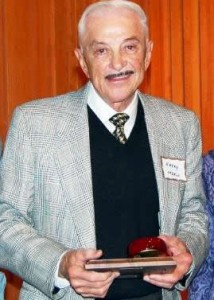 As a long time businessman & philanthropist in the Portland area, Harry Merlo has had a hand in the local sports world on high school, collegiate, and professional levels.
As a long time businessman & philanthropist in the Portland area, Harry Merlo has had a hand in the local sports world on high school, collegiate, and professional levels. With specific ties to tennis & soccer, he’s provided key infrastructure and financial support that have kept our athletes training & competing at elite levels.
In the early eighties, Merlo had the unique opportunity to sponsor an initiative to bring the Davis Cup to the Rose City. He jumped at the chance, and the world’s largest annual international team competition chose Portland to host two semifinal rounds in 1981 & 1984, boosting our local economic development and employment by hundreds of millions of dollars.
Not only has he had financial impact in the sports world, but Merlo also directed the effort behind drafting the first United States Tennis Association Code of Conduct, which has been in effect to ensure appropriate sportsmanship since 1985.
His other significant donations include beneficiaries like the USTA, Portland Timbers, the University of Portland, Jesuit High School, and many other organizations through his own enterprise: the Merlo Foundation.
Merlo spent more than two decades as the CEO of Louisiana-Pacific Corporation, after which he has since focused on multiple other projects and business ventures. He still lives in the Portland area.
2018
- Columbia Sportswear, Tim & Gert Boyle - Special Contribution
-
2018
It takes a tough mother to run a thriving business these days. Fortunately, Columbia Sportswear has one of those, with a son who is a pretty good wing man himself.
Gert and Tim Boyle have made civic engagement and giving a huge part of the Columbia Brand over the past 40+ years as well as supporting the health and well-being of Oregonians and athletes of all nations.
You have seen the support in the branding. Columbia has contributed to Special Olympics, outfitting team USA for the 1995 World Games. Royalties from Gert Boyle’s “One Tough Mother” book still go to Special Olympics. Multi-year sponsorship of the US, Canadian and Russian freestyle ski teams. Three-year title sponsor of Team Columbia in the Tour de France.
Columbia also sponsors pro golfers and professional fishing.
Away from the bright lights, Columbia Sportswear has contributed $100 million to advance cancer research at Oregon Health and Sciences University; made multiple contributions to build University recreational facilities around the state of Oregon and provided funding to save Outdoor School in Portland which benefits thousands of youth.
Tim Boyle has made generous gifts to the University of Oregon and recently pledged $1.5 million dollars to a new project addressing homelessness in Portland.
It takes a tough mother. But is also takes a generous and forward-thinking mother… and son. As Columbia Sportswear celebrates it’s 80th year, please join us in honoring Tim and Gert Boyle of Columbia’s Sportswear for their Special Contribution to Sports at the Oregon Sports Hall of Fame.